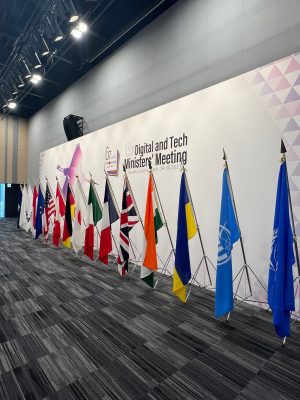The leaders of the G-7 nations and the European Union gather in Hiroshima, Japan, starting on May 19. But their summit is being preceded by a series of ministerial meetings in various picturesque cities in Japan to lay the groundwork on a number of important topical issues. As the current cold war atmosphere between the U.S.-led Western allies and China centers around technology competition, the G-7 digital and tech ministers’ gathering in Takasaki, Gunma Prefecture, in late April took on special importance.
With relatively little fanfare, a Ministerial Declaration was issued with six sections, identifying the areas where these leading Western democratic nations are focusing their efforts as they try to sustain technological leadership. That leadership is widely considered to be under threat from global geopolitical tensions and in particular, competition from China.
The first of these six points, “facilitation of cross-border data flows and data free flow with trust,” reaffirms the importance of building and realizing trust “through various legal and voluntary frameworks, guidelines, standards, technologies and other means that are transparent and protect data.” The ministers recognized the need to accelerate progress in this regard by establishing and launching the Institutional Arrangement for Partnership (IAP), “to bring governments and stakeholders together to operationalize ‘data free flow with trust’ (DFFT) through principles-based, solutions-oriented, evidence-based, multistakeholder and cross-sectoral cooperation.” The declaration set a goal of launching the IAP “in the coming months.”
The second point, “secure and resilient digital infrastructure,” is also clearly an area that has been drawing heightened concern recently, with growing geopolitical concerns over redundancy in face of potential disruptions. The digital ministers affirmed the important need to “develop, deploy and maintain various multi-layered networks consisting of terrestrial networks, submarine cable networks, and non-terrestrial networks.” The declaration calls for extending “secure and resilient digital infrastructure to like-minded partners, including developing and emerging economies.”
The ministers paid particular attention to the need to extend secure routes of submarine cables. In particular, the G-7 governments will work with the World Bank and the private sector telecom operators to undertake submarine cable projects with subsidies from G-7 nations and other international institutions. The goal is to support the critical infrastructure development of underserved regions in the world that have not received sufficient private investment. Specifically, Japan has committed to host “an event and identify concrete areas of cooperation with the World Bank in 2023 to accelerate the strengthening of synergies between the G-7 and the Bank.”`
Recent media investigative reports have pointed out that China’s Belt and Road Initiative (BRI) has been pivoting from large-scale infrastructure projects to less capital-intensive areas], particularly in the field of digital infrastructure. Examples includes constructing a new government data center for Senegal, supported by Huawei, which also spearheaded another undersea cable project for Senegal with the island nation of Cape Verde, making Senegal an African regional cable hub. Previously commonly labeled as the “Digital Silk Road” strategy, such investments in information and communications technology (ICT) and electronic components reached $17.6 billion in 2022, six times the amount in 2013, when the BRI was launched, according to reports from Nikkei Asia and the Financial Times’s fDi Markets foreign direct investment monitor. The United States and its partners will have a lot of catching up to do.
The third point in the G-7 declaration, “internet governance,” echoes the expressed endorsement in the U.S.-led Declaration for the Future of the Internet for the multistakeholder model, which is seen as being challenged by China, Russia and other autocratic nations that hope to steerinternet governance toward a government-driven, top-down model. The fourth point, “emerging and disruptive technologies in innovating society and economy,” is, however, just a pledge of support for cooperation in policy setting for a mixed bag of different technologies, from Internet of Things to digital identity, and from semiconductor supply chain to the metaverse.
The fifth point specifically focused on “responsible AI and global AI governance,” reaffirming that AI policies and regulations should be “human centric and based on democratic values, including protection of human rights and fundamental freedoms and the protection of privacy and personal data.” However, the meeting only concluded with an “action plan for promoting global interoperability between tools for trustworthy AI,” with little concrete agreement on how to deal with the growing concerns over the untamed development and proliferation of generative AI.
Interestingly, the final point, “digital competition,” is an acknowledgement of the tensions between G-7 nations, particularly across the Atlantic, between the United States and Europe, over the wide gap in regulatory principles and laws overseeing the competition in digital markets. The meeting agreed to convene a summit on digital competition for regulators and policymakers in the fall of 2023 to facilitate promotion of competition and enforcement.
Further to these discussions, on May 12-14, the G-7 science ministers will gather in Sendai, Japan, to discuss cooperation on scientific research, funding transparency, research data sharing on sensitive technologies, etc.
All in all, as the United States has unveiled international economic policy, through cooperation with its partners, with its centerpiece focusing on technological competition with China, it can be expected that the G-7 will play a crucial role in establishing and pursuing a more coherent strategy on multiple fronts. The G-7 digital and tech ministers’ declaration offers hints to the priorities and approaches of the allies, as well as how it may engage the other advanced as well as emerging economies, such as those outside of the G-7 that are strategically invited to the upcoming summit like Australia, Brazil, India, South Korea, and Vietnam. It should not surprise anyone that technology competition will be a key center of attention and actions in Hiroshima.
































